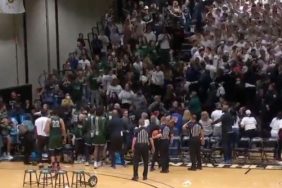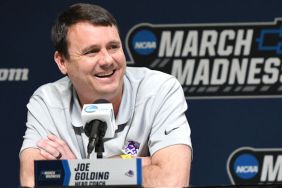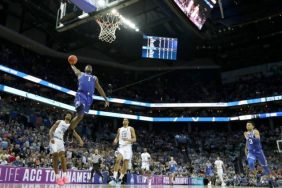If you’re just now filling out a bracket for the first time, congratulations, you’re going to win your pool.
It’s a proven fact there is such thing as ‘beginner’s luck’ when it comes to March Madness. Whether it be because we, who follow basketball, pick with our hearts instead of our heads, or possibly because we can’t fathom picking against certain players or coaches, most pools throughout the country will be won by your best friend’s sister. I should know. I won my first bracket pool as a teenager in 2001, finishing in the top 98th percentile in all of Yahoo — haven’t won a penny since.
So instead of watching every single analyst on television, reading every blog or developing your own rating system for every team — something I actually did several years ago — I’ll save you some trouble.
Just guess.
Take 5 minutes to fill out your bracket, and you’ll likely win. Seriously, the less time you think about this by using one of the methods below, the more likely you are to bringing home the cheddar. Even if that cheddar is a hand full of pride.
But first, a few ground rules:
Rule #1
Advance all No. 1 and No. 2 seeds to at least the second round. Go ahead, just pen them in. In fact, I would pen them into the Sweet 16 automatically as well.
A No. 1 seed has never lost in the first round to a No. 16 and a No. 15 has only beaten a No. 2 seed eight times, ever.
That’s a 128-0 record in the first round for No. 1’s. And 86% of the time, No. 1 seeds advance to the Sweet 16.
Rule #2
Don’t get too crazy and pick all No. 1 seeds to the Final Four. All four No. 1 seeds making the final weekend has only happened once (2008).
Picking your winners
Now we move on to selecting the other 50+ games. Don’t worry about getting them all right. The odds of that happening, according to statisticians, is just one in 9.2 quintillion — whatever that number is.
Remember, the goal is to simply win your pool, which, in order to do, means you’ll have to nail the Final Four.
Here’s how to pick your teams.
The stats method
Numbers don’t lie. Just look at some key stats and trends from the tournament. Here are a few of my favorites from this year from ESPN:
How many upsets should you go with in the first and second rounds? BPI expects 5.2 double-digit seeds to make the Round of 32 and 1.4 to make the Sweet 16. Which teams to pick is a much more difficult decision.
The 12-5 matchup is a fan favorite and the 12-seed has won at least one game in four out of the past five years. This year there is a 72 percent chance we see at least one 12-seed beat a 5-seed.
Want a small conference team that could surprise people and make it to the Sweet 16 and perhaps further? Saint Mary’s is ranked 12th in BPI and is playing its opening weekend games in Salt Lake City, a city familiar to the Gaels, as it is 38 miles from where they play BYU once a year.
The mascot method
If the two mascots fought, which would come out alive?

The Gonzaga Bulldogs are favored by many to reach their first Final Four. But can they slay a wildcat … or a commodore?
Have some fun. Who wins between a fighting Irishman and a tiger? A duck or a gael? What’s a gael? …
Proximity method
Simple. Whichever team is playing closer to their home court wins. For instance, take KU, who opens the tournament down the road in Wichita and will then be even closer to home when they play the regional final at Sprint Center in Kansas City.
The school colors method
Go ahead and pick your favorite colors. Blue usually does pretty good: UNC, Duke, UK, KU, WVU, UCLA, Gonzaga, Villanova (who win it last year) … etc.
The cute coach method
I hate including this. I really do. Yet I do it every year. Because, I’m not kidding, my best friend’s mom won a bracket pool 200-large on this method.
If it comes down to the handsomeness of Steve Alford or John Calipari, who you taking? Both have great hair. Maybe that’s what I’ll call this method in the future — which coach has the best hair??

Both UCLA and Kentucky have a solid chance at making a Final Four run solely on their coach’s locks. They’ve so been to Bosley.
The cheerleader method

Donald is one lucky duck.
Although UCLA makes another run with this method, I’m picking the Oregon Ducks yet again. I mean holy shmoly.
The Vegas method
Simply look at Vegas odds.
Who has the best chance to win it all? Here’s what we got as of Tuesday.
Duke: 13/2
North Carolina: 13/2
Kansas: 15/2
Villanova: 15/2
Gonzaga: 17/2
Arizona: 9/1
Kentucky: 10/1
UCLA: 12/1
Louisville: 16/1
Oregon: 22/1
Purdue: 22/1
Michigan: 25/1
West Virginia: 25/1
Baylor: 28/1
Florida: 33/1
Florida State: 33/1
Virginia: 33/1
Iowa State: 40/1
Notre Dame: 40/1
SMU: 40/1
And finally … The Brad Evans method
I’ve finished near the top 70% of yahoo brackets the past three years after speaking with Yahoo March Madness expert Brad Evans. That’s why I’m going with this stud muffin from Champaign, IL.
Whichever expert you choose, pick one and stick with the advice of a guy who’s been eating and breathing college hoops all season, which in my opinion, is Brad.
Some of his advice for this year:
According to KenPom.com, Gonzaga is one of a few of teams since 2010 to rank inside the top-10 nationally in adjusted offensive and defensive efficiency. Other members of that group – 2010 Duke, 2012 Ohio St., 2015 Kentucky and 2016 Villanova – either attended the Final Four or won a national championship. Consistency on both ends is paramount for any team to make a deep run. The ‘Zags undoubtedly have it.
(other under dogs he likes)
Michigan
Wichita State
Bucknell
UNC-Wilmington

Although they’re a No. 7 seed, watch out for the Michigan Wolverines as a potential cinderella, a team who just won the Big 10 Tournament.
Other tips:
1. Top dogs don’t necessarily pack the most vicious bite
Since the tournament expanded to its current capacity in 1985, just over 41-percent of No. 1 seeds have advanced onto the Final Four. During that span, only once have all four top seeds made it to the Mecca of college hoops (2008). Typically, the Final Four features two No. 1s and two lower seeded teams from the Nos. 2-4 range.
2. Don’t fall in love with too many Cinderellas
Selecting upsets is a bragging exercise. Everyone wants to boast to their buddies they had the stones to pick a team from the Ivy League. But becoming enamored with an abundance of underdogs can bloody your bracket in a hurry. Shocker specials do and will happen, but not nearly as often as many would lead you to believe. Approximately 14-15 percent of top seeds per season are bounced early. That trend, though, is rising. Over the past five years, roughly 19 percent of big boys have gone home crying. Last season, due to knockouts levied by Dayton, UCLA, NC State and Georgia State, 17 percent of higher seeds were bitten by the upset bug. Obviously, don’t pick by the book. Just be mindful underdogs only occasionally topple regional favorites, especially over multiple rounds.
3. When you do court Cinderella, think offense
Defense may win championships, but when it comes to the NCAA Tournament offense most often defines upsets. Of the teams seeded No. 11 or lower that marched out of Round 1 over the past 10 years, 63 percent had an offensive efficiency rank of No. 75 or better. Among this year’s batch of double-digit seeds South Dakota St, Stephen F. Austin and Gonzaga are squads that fit the trend.
4. Team balance wins championships … most of the time
If you comb through the NCAA tournament annals, one key predictive metric stands out among Final Four participants, a small differential between offensive and defensive efficiency. Well-rounded teams that force turnovers, guard the glass, generally frustrate opponents and score the basketball consistently are, predictably, difficult to eliminate. According to the ridiculously addictive site KenPom.com, the average efficiency differential (offense-to-defense) of championship teams from 2002-2015 was -5.7. The average offensive efficiency rank was 7.21, defensive was 12.91. Interestingly, the disparity among Final Four participants during that span was just shy of +2.0. Of this year’s batch of single-digit seeds ranked inside the top 25 in offensive and defensive efficiency, Virginia, Kansas, Villanova and Oklahoma have the tightest separation in the those categories.
You can read more from Brad here. Definitely go to Yahoo and fill out your bracket here.
Josh Helmuth is the editor of Crave Sports. Follow him on Twitter or like the channel on Facebook.








